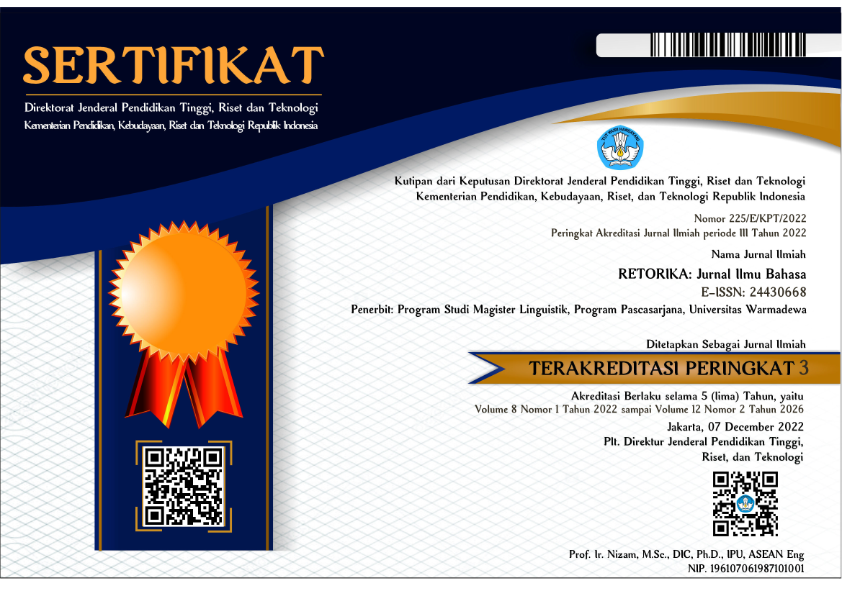Analysis of Speech and Thought Presentation in Children’s Storybook Frozen: A Stylistic Study
Abstract
Stylistic speech and thought presentation play crucial roles in shaping characters and enriching readers' experiences in children’s storybooks. This study delved into the depiction of speech and thought in the "Frozen" Storybook, an adaptation of Disney's 2013 film. Employing a non-participant descriptive qualitative methodology, the research analyzes internet-accessible data, employing the framework proposed by Leech and Short (2007), categorizing speech and thought into ten distinct categories. The analysis uncovers eight presentation types across twenty-two instances, with speech representation occurring twelve times and thought representation ten times. Predominant categories include IS (Indirect Speech), FIT (Free Indirect Thought), and NRTA (Narrative Report of Thought and Action), each appearing four times. Additionally, FDS (Free Direct Speech), DS (Direct Speech), FIS (Free Indirect Speech), and IT (Indirect Thought) occur three or two times, while NRSA (Narrative Report of Speech Act) occurs once. Notably, DT (Direct Thought) and FDT (Free Direct Thought) are absent. Analyzing speech and thought presentation in children’s storybooks yields insights into characters' communication and cognition, aiding readers, particularly children, in understanding motivations, emotions, and personalities. Furthermore, it fosters language development and enhances comprehension skills by exposing young readers to diverse presentation forms. Additionally, it contributes to literary analysis by elucidating authors' stylistic choices and their storytelling impacts. Ultimately, examining speech and thought presentation enhances both reading experiences and scholarly discourse on children’s literature.
References
Adiningtyas, J. (2021). Thought Presentation in Veronica Roth’s “Divergentâ€: Stylistic Analysis. Journal of English Language and Literature 11 (1). https://doi.org/10.30813/jelc.v11i1.2400
Ahmad, S., & Nadarajan, S. (2020). Thought Presentation in Alice Sebold's the Lovely Bones. Journal of Language and Literature, 20(1), 70. https://doi.org/10.24071/joll.v20i1.225
Ali Mahmoud, N. (2019). Thought Presentation in Nicholas Sparks’ the Guardian: A Stylistic Analysis. Textual Turnings: An International Peer-Reviewed Journal in English Studies, 1(1), 344–356. https://doi.org/10.21608/ttaip.2019.123797
Astri, Z. (2017). The Typical Linguistic Feature of English Used by Indonesian Tourist Guide. In Proceedings The 2nd Annual Seminar on English Language Studies (pp. 33-47).
Ayoub A., & Mohammadzadeh, B. (2021). Speech and Thought Presentation in Chance by Alice Munro: A Stylistic Analysis. Advances in Language and Literary Studies, 12(1), 77. https://doi.org/10.7575/aiac.alls.v.12n.1.p.77
Buck, C., & Lee, J. (2013). Frozen. Walt Disney Studios Motion Pictures.
Burke, M. (2014). The Routledge Handbook of Stylistics. London: Routledge.
Creswell, J. W. (1994). Research Design: Qualitative & Quantitative Approaches. Sage Publications, Inc.
Evans, M. (2020). Presenting Speech and Thought. Language in Conflict. Retrieved from https://languageinconflict.org/the-world-through-language/presenting-speech-and-thought.html
Guo, H. (2017). Free Indirect Thought in Stream-of-Consciousness Fiction: A Textural Cohesive Perspective. International Journal of English Linguistics, 7(6), 38. https://doi.org/10.5539/ijel.v7n6p38
Hakemulder, F. (2020). Finding Meaning through Literature: ‘Foregrounding’ as an Emergent Effect. Anglistik: International Journal of English Studies, 31(1). 91-110. http://dx.doi.org/10.33675/ANGL/2020/1/8
Hoover, D.L. (2008). Style and Stylistics. In a Companion to the History of the English Language (eds H. Momma and M. Matto). https://doi.org/10.1002/9781444302851.ch56
Isti’anah, A. (2018). Speech and thought Presentation in Jhumpa Lahiri’s Interpreter of Maladies. Elite: English and Literature Journal, 5(2), 111-123. https://doi.org/10.24252/elite.v5i2a1
Jayal, J. (2013). Stylistic Analysis of Leo Tolstoy's Short Story: God Sees the Truth, but Waits. The Criterion: An International Journal in English, 12(), 1-9. Retrieved from https://www.the-criterion.com/stylistic-analysis-of-leo-tolstoys-short-storygod-sees-the-truth-but-waits/
Jeffries, L., & McIntyre, D. (2010). Stylistics. Cambridge University Press.
Leech, G. N., & Short, M. H. (1981). Style in Fiction. London: Longman.
Leech, G. N., & Short, M. H. (2007). Style in Fiction; A Linguistic Introduction to English Fictional Prose. Second Edition. Har-low. Pearson.
Malu, K. F. (2013). Exploring Children’s Picture Storybooks with Adult and Adolescent EFL Learners. English Teaching Forum, 51(3), 10–18.
Murphy, T. P. (2009). Thought and Speech Presentation in Fiction, With Notes on Film Adaptation. Situations, 3(Winter), 21–49.
Semino, E., & Short, M., (2004). Corpus Stylistics: Speech, Writing, and Thought Presentation in a Corpus of English Writing. London: Routledge.
Thompson, G. (1996). Voices in the text: Discourse perspectives on language reports. Applied linguistics, 17(4), 501-530. https://doi.org/10.1093/applin/17.4.501
Wirartha, I. (2006). Metode Penelitian Sosial Ekonomi. Yogyakarta: Andi offset.
Copyright (c) 2024 RETORIKA: Jurnal Ilmu Bahasa

This work is licensed under a Creative Commons Attribution-ShareAlike 4.0 International License.
This journal provides immediate open access to its content on the principle that making research freely available to the public supports a greater global exchange of knowledge.
All articles published Open Access will be immediately and permanently free for everyone to read and download. We are continuously working with our author communities to select the best choice of license options, currently being defined for this journal as follows: Creative Commons-Non Ceomercial-Attribution-ShareAlike (CC BY-NC-SA)
 Abstract viewed = 50 times
Abstract viewed = 50 times
 PDF downloaded = 30 times
PDF downloaded = 30 times

2.png)














